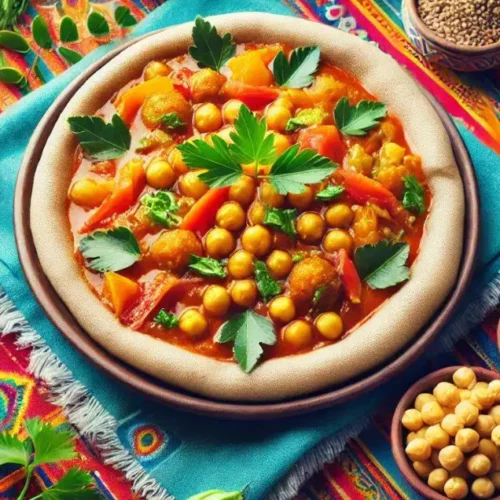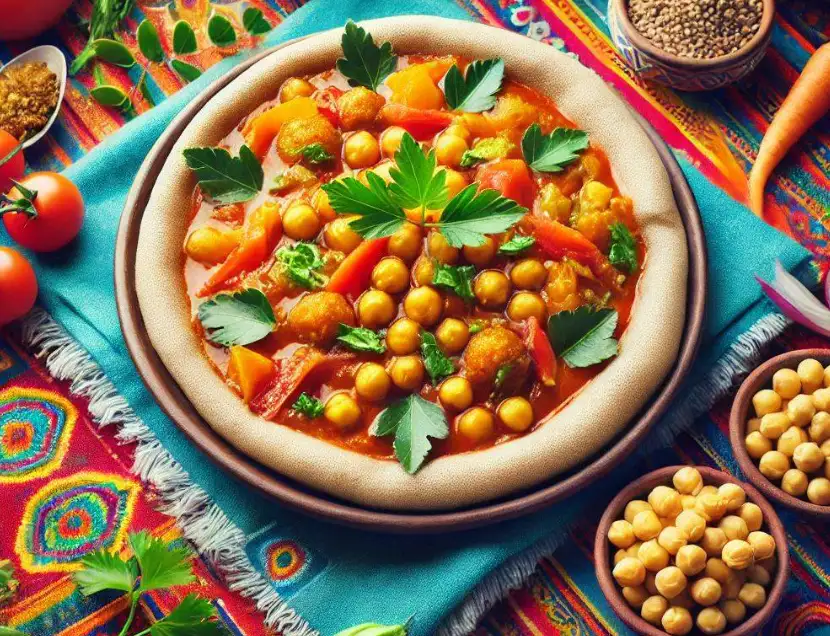Are you tired of the same old meals and looking for something new to excite your taste buds? Imagine a dish bursting with aromatic spices and hearty chickpeas, offering a comforting yet exotic flavor profile. The problem is, many unique recipes seem too complicated or require hard-to-find ingredients. Enter Chickpea Wat—an Ethiopian stew that’s rich in tradition, easy to make, and packed with wholesome goodness. This guide will show you how to bring this flavorful dish to your table with ease.
What is Chickpea Wat?
Chickpea Wat is a variation of Ethiopian “wat,” a term for slow-cooked stews often spiced with berbere, a blend of aromatic spices like paprika, cumin, coriander, and cinnamon. Traditionally served with injera, a spongy flatbread made from teff flour, Chickpea Wat is a vegan-friendly option that offers a nutrient-packed meal.
Ethiopian cuisine shares similarities with Indian cooking, especially in its use of spices, but the unique combination in berbere gives these dishes their distinctive character. Chickpea Wat is typically made with caramelized onions, garlic, ginger, chickpeas, tomatoes, and a robust spice mix.
Why Try Chickpea Wat?
- Nutritional Benefits: Chickpeas are an excellent source of protein, fiber, and essential minerals, making this dish both filling and wholesome.
- Versatility: Chickpea Wat can be adapted to your taste, whether you prefer it spicy, mild, or with additional vegetables like spinach or collard greens.
- Meal Prep-Friendly: This stew tastes even better the next day, freezes well, and makes for a convenient, healthy meal.

Step-by-Step Recipe for Chickpea Wat
Ingredients
- 3 cups cooked or canned chickpeas 1 lb dried chickpeas, soaked overnight
- 1 large red onion diced
- 1 tbsp butter or ghee substitute with oil for vegan
- 1 tbsp minced garlic
- 1 tbsp minced ginger
- 1 can 15 oz diced tomatoes
- 2-3 cups vegetable or chicken broth
- 10 oz frozen chopped spinach optional
- For the Berbere Spice Mix:
- 1 tbsp paprika
- 1/4-1 tsp cayenne pepper adjust to your spice tolerance
- 3/4 tsp cumin
- 1/2 tsp ground black pepper
- 1/2 tsp ground cardamom
- 1/2 tsp coriander
- 1/4 tsp cinnamon
- 1/4 tsp ground cloves
- Salt to taste
- Optional Roasted Chickpeas:
- If you want added texture roast chickpeas at 450°F for 30 minutes with a drizzle of olive oil, stirring occasionally.
Instructions
- Caramelize the Onions: In a large pot, heat butter or ghee over medium heat. Add diced onions and cook until soft and caramelized, about 10 minutes.
- Build the Flavor Base: Stir in garlic, ginger, and the berbere spice mix. Cook for 1-2 minutes, stirring frequently to release the aroma of the spices.
- Combine Chickpeas and Tomatoes: Add chickpeas and diced tomatoes to the pot. Stir to coat the chickpeas with spices.
- Simmer: Pour in the broth and bring the mixture to a boil. Reduce the heat to low and let it simmer for 30 minutes. For dried chickpeas, extend the cooking time to 1.5 hours, adding water as needed.
- Thicken the Wat (Optional): Blend half of the stew with an immersion blender or transfer to a blender, then return it to the pot. This creates a creamier texture while retaining some whole chickpeas for a hearty feel.
- Add Greens: If using spinach, stir it in during the last 10 minutes of cooking.
- Serve: Enjoy Chickpea Wat with injera, naan, pita, or even rice. For added creaminess, top with a dollop of yogurt.
Cultural and Culinary Context
Ethiopian cuisine is deeply rooted in community and tradition. Meals are often shared from a single platter, fostering a sense of togetherness. The use of injera as both a plate and utensil is an eco-friendly and flavorful way to enjoy stews like Chickpea Wat.
Frequently Asked Questions
1. Can I make Chickpea Wat spicier or milder?
Absolutely! Adjust the cayenne in the berbere mix to suit your spice preference.
2. What can I use as a substitute for injera?
If teff flour is unavailable, serve Chickpea Wat with naan, pita, lavash, or even over rice.
3. Can I add other vegetables?
Yes, collard greens, kale, or roasted vegetables like sweet potatoes are great additions.
4. Is it freezer-friendly?
Yes, Chickpea Wat freezes well. Store in an airtight container for up to 3 months.
Conclusion
Chickpea Wat is more than just a meal; it’s an invitation to explore Ethiopian flavors and traditions. Whether you’re a seasoned cook or trying Ethiopian cuisine for the first time, this dish offers a delightful blend of simplicity, taste, and nourishment. Try it today and bring a touch of Africa to your table!

